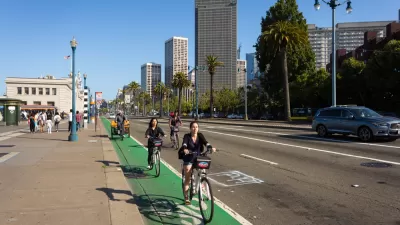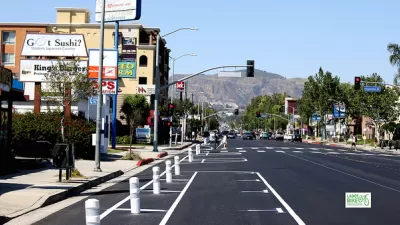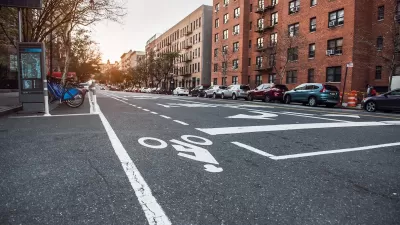The state’s transportation agency will be required to prioritize multimodal transportation infrastructure and improve transparency.

Among the many bills signed by California Governor Gavin Newsom last week is the state’s first Complete Streets law, reports Melanie Curry for Streetsblog California.
“S.B. 960 requires Caltrans to prioritize road improvements for pedestrians, bike riders, and public transit users whenever it performs maintenance or does road work. That can include sidewalks, bike lanes, bus-only lanes, comfortable and accessible public transportation stops, frequent and safe crosswalks, median islands, accessible pedestrian signals, curb extensions, narrower travel lanes, and more.” The law also calls for a “more transparent decision process” when local governments want to make safety improvements on state-managed roads, a move sometimes blocked by state agencies.
In addition to pedestrian and bike infrastructure, the bill requires Caltrans to develop a plan for prioritizing public transit, which “should make infrastructure like bus lanes and protected bus stops easier and faster to build.”
Curry notes that the law “still offers Caltrans ways to avoid doing the work that's needed,” and that local advocates must remain vigilant.
The article details another new law, AB 2086, that requires Caltrans to conduct a financial analysis of its California Transportation Plan. “Right now, this plan, which lays the groundwork for the state's future transportation system, is an ‘aspirational’ plan without any solid discussion of funding sources - nor of where current funding is being spent or could be better spent.”
FULL STORY: Governor Newsom Signs Complete Streets Bill

Maui's Vacation Rental Debate Turns Ugly
Verbal attacks, misinformation campaigns and fistfights plague a high-stakes debate to convert thousands of vacation rentals into long-term housing.

Planetizen Federal Action Tracker
A weekly monitor of how Trump’s orders and actions are impacting planners and planning in America.

San Francisco Suspends Traffic Calming Amidst Record Deaths
Citing “a challenging fiscal landscape,” the city will cease the program on the heels of 42 traffic deaths, including 24 pedestrians.

Adaptive Reuse Will Create Housing in a Suburban Texas Strip Mall
A developer is reimagining a strip mall property as a mixed-use complex with housing and retail.

Study: Anti-Homelessness Laws Don’t Work
Research shows that punitive measures that criminalized unhoused people don’t help reduce homelessness.

In U.S., Urban Gondolas Face Uphill Battle
Cities in Latin America and Europe have embraced aerial transitways — AKA gondolas — as sustainable, convenient urban transport, especially in tricky geographies. American cities have yet to catch up.
Urban Design for Planners 1: Software Tools
This six-course series explores essential urban design concepts using open source software and equips planners with the tools they need to participate fully in the urban design process.
Planning for Universal Design
Learn the tools for implementing Universal Design in planning regulations.
Heyer Gruel & Associates PA
JM Goldson LLC
Custer County Colorado
City of Camden Redevelopment Agency
City of Astoria
Transportation Research & Education Center (TREC) at Portland State University
Jefferson Parish Government
Camden Redevelopment Agency
City of Claremont





























